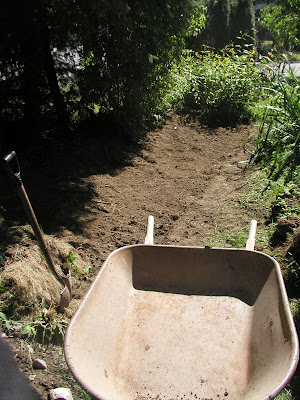

I have been working on:

It's a start. There's much more to be done. Salvaged stone and brick will be used, and the garden will be extending further both ways - actually three ways, as the front part, curving along the path-to-be, will be coming further out and more bushes planted.
Those wood and foliage chippings,
were all used up.
I'll re-seed that grass.
I mixed sand into the chippings, as well as some of the native soil that I originally dug out. And where I put the plants in (the ones that I have put in so far), I did a mix of the same but with peat and saw dust as well.
Here's some of the plants:
Lingonberries (Vaccinium vitis-idaea).

I hope to have the lingonberries as the main planting.
Here is Bearberry (Arctostaphylos), or Kinnikinnick:
And this one I am looking forward to:
It is an evergreen huckleberry (Vaccinium ovatum - var.‘Thunderbird’) found in Tofino on Vancouver Island.
Here's an interesting one I found at the nursery:
It is Gaulnettya wisleyensis (Wisley Pearl). It is a cross between gaultheria (Salal) and pernettya.
And my favourite of all, the red huckleberry - Vaccinium parvifolium - (not a true huckleberry):

You have to go into the woods for them. As I said before, there's a reason why you do not see them in cultivation. They only grow on the decomposition of evergreens, mostly douglas fir. I need to find rotting material and some douglas fir stumps/logs. These two specimens I took from Redwood Park. I made sure to take some of the deep red, long advanced wood-rot of the fallen tree they were growing on.
Taking bareroot specimens of red huckleberry is difficult. It is impossible if you try and take one that is a big bush, or even a medium bush, as the roots go out far and you cannot dig up the entire root system to support that large a plant. So you find the smallest ones, and dig up as much root as possible; then when you plant it you clip off some of the stem and leaves. The ones pictured above have their native soil beneath the peat moss that I put on top.
I took them from the woods about three weeks ago, or more. They seem to be doing alright.
Friday, October 9, 2009
Garden Sprawl Friday
In this post from August I wrote about two projects for the front and back. The back still remains the same, but the front (planned as a B.C. native garden),
Subscribe to:
Post Comments (Atom)


No comments:
Post a Comment